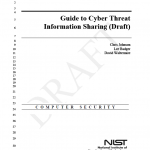
As the magnitude and complexity of cyberspace increases, so too does the threat1 landscape. Cyber attacks have increased in both frequency and sophistication resulting in significant challenges to organizations that must defend their infrastructure from attacks by capable adversaries. These adversaries range from individual attackers to well-resourced groups operating as part of a criminal enterprise or on behalf of a nation-state. These adversaries are persistent, motivated, and agile; and employ a variety of tactics, techniques, and procedures (TTPs) to compromise systems, disrupt services, commit financial fraud, expose sensitive information, and steal intellectual property. To enhance incident response actions and bolster cyber defenses, organizations must harness the collective wisdom of peer organizations through information sharing and coordinated incident response. This publication expands upon the guidance introduced in Section 4, Coordination and Information Sharing of NIST Special Publication (SP) 800-61, Computer Security Incident Handling Guide and explores information sharing, coordination, and collaboration as part of the incident response life cycle.
